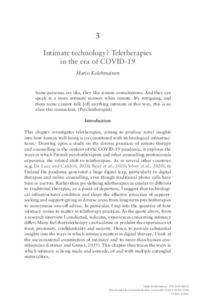Intimate Technology? Teletherapies in the era of COVID-19
Kolehmainen Marjo
https://urn.fi/URN:NBN:fi-fe2022112968084
Tiivistelmä
This chapter investigates teletherapies, aiming to produce novel insights into how human well-being is co-constituted with technological infrastructures. Drawing upon a study of the diverse practices of remote therapy and counselling in the context of the COVID-19 pandemic, it explores the ways in which Finnish psychotherapists and other counselling professionals experienced the shift to teletherapies. I suggest that technological infrastructures condition and shape the affective processes of support-seeking and support-giving. In particular, I tap into the question of how intimacy comes to matter in teletherapy practices. The chapter thus traces the ways in which intimacy is being made and unmade, of and with multiple entangled materialities, thus enriching our understanding of affective intimacies by stressing how intimacy is co-constituted by several dynamic processes that have capacities to affect and become affected. Analysing the interviews through the lens of intra-action, I discuss both the capacities to bring close and the capacities to distance that are facilitated by teletherapy practices. The chapter concludes that the distancing capacities are not distinct from those capacities that generate the feelings of proximity. Rather they both exemplify the distributed agencies of entangled materialities. Further, my study highlights that in mental care agency is distributed across various human and non-human actors: from professionals and clients to therapy venues, from psychic conditions to legislation, from technological equipment and software apps to economic factors.
Kokoelmat
- Rinnakkaistallenteet [27094]
